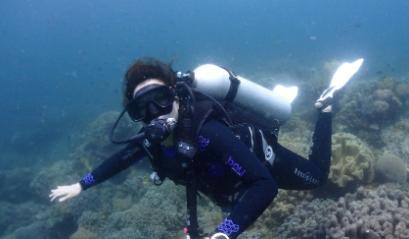Sea creature superpowers
Dr Goggolidou is a Reader in Molecular Genetics in the Faculty of Science and Engineering.

A recent diving safari saw genetics researcher Dr Evi Goggolidou reflect on the amazing genepool of ocean creatures. From sharks that don’t get cancer to whales protecting themselves from extinction, she explains more about the superpowers of sea life.
Taking a break from teaching genetics and doing experiments in the lab, I went to a scuba diving trip to the Red Sea. I had an amazing ten days, diving in coral reefs, admiring the diversity and beauty of nature and swimming alongside colourful fish. My most interesting encounter however was with two teenager white tip sharks, one morning when we accidentally came across their home in a coral reef. They are a species of unique beauty and one of the most admirable creatures I have come across.
Sharks are a diverse species and over the years the great white shark has attracted public fascination and media attention; remember Jaws? In an attempt to understand the biology of this stunning predator, scientists have read its whole DNA, generating information on the genes that constitute it and their properties.
It turns out that the shark gene pool (genome) is one and a half times the size of the human genome and it contains genetic properties that could be the reason behind the longevity of this large sized species. In particular, scientists found that the white sharks’ DNA contains adaptive changes on a number of genes associated with DNA repair, damage response and stability. This enables them to more efficiently repair damaged DNA, something humans struggle with. DNA damage has been shown to predispose humans to age-related diseases and cancer. In addition, the white shark genome contained a great number of a particular type of DNA sequences, known as LINEs, known to damage DNA. Yet although the shark genome contains a high number of LINEs, it has developed an evolutionary mechanism to efficiently repair its DNA, so these sequences do not threaten its survival.
The above findings are significant as on top of them, it has also been shown that larger bodied species that contain more cells and live longer, have more chances of developing cancer; the opposite of this is however observed in sharks. Even more significantly, white sharks contain a large number of genes that control wound healing, as well as a key blot clotting gene, enabling them to rapidly repair large wounds.
Another large bodied sea creature that has got unique properties is the whale. When researchers studied the DNA of a particular humpback whale that lives off the coast of Massachusetts, they discovered that the size of its genome is slightly smaller than the human genome. Significantly, the humpback whale genome contained duplications of many tumour suppressor genes, which explains why whales are less prone to cancer. On top of this, it was found that whales accumulate fewer mutations in their DNA, protecting them from possible extinction. Some parts of the humpback whale genome had evolved more rapidly than other parts and they contained genes that controlled cell survival, communication and destiny.
As a scuba diver who over the years has struggled with buoyancy and oxygen consumption, I find the ability of dolphins to dive in great depths for over 90 minutes greatly fascinating. During these dives, dolphins are able to deprive their vital organs such as the heart, lungs and kidneys from oxygen, in order to allow more oxygen to travel to their brains. After resurfacing, dolphins are able to restore oxygen to their organs without damaging them. In humans, the same phenomenon of oxygen depravation (hypoxia) or rapid changes in oxygen levels, as experienced in heart attack, stroke and acute kidney injury, causes the release of free radicals which damage the organs. Scientists have now shown that dolphins contain high levels of specific proteins in their serum, which have antioxidant properties and thus allow them to not be affected by changes in oxygen levels.
It becomes obvious from the above that sea creatures contain unique properties that allow them to survive and thrive in extreme environments. Studying these species will therefore enable us to better understand the mechanisms that nature has developed to fight cancer, hypoxia and age-related diseases and use the sharks’ wound healing properties to more efficiently repair wounds in humans.
Article references:
https://www.pnas.org/content/116/10/4446
https://academic.oup.com/mbe/advance-article/doi/10.1093/molbev/msz099/5485251
https://www.nature.com/articles/srep33879
For more information please contact the Corporate Communications Team.


/prod01/wlvacuk/media/departments/digital-content-and-communications/images-2024/240328-Varsity-Line-Up-Resized.jpg)
/prod01/wlvacuk/media/departments/digital-content-and-communications/images-18-19/220325-Engineers_teach_thumbail.jpg)
/prod01/wlvacuk/media/departments/digital-content-and-communications/images-2024/240404-Digital-Humanities-Training-Resized.jpg)
/prod01/wlvacuk/media/departments/digital-content-and-communications/images-2024/240320-Uzbekistan-Resized.jpg)
/prod01/wlvacuk/media/departments/digital-content-and-communications/images-2024/240229-The-Link-Resized.jpg)
/prod01/wlvacuk/media/departments/digital-content-and-communications/images-2024/240411-IYC-Resized.jpg)